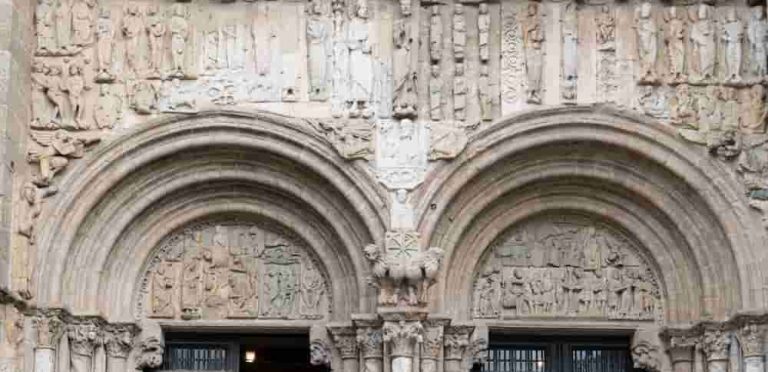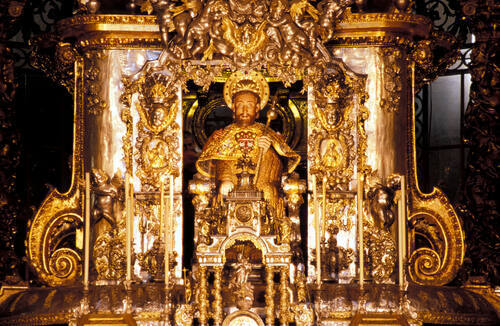The History and Cultural Significance of the Cathedral of Santiago de Compostela
The Creation of the Cathedral:
After the discovery of the tomb of St. James in Galicia, Santiago de Compostela Spain, the city became one of the greatest pilgrimages in Europe. The modest church erected in the 9th century became the grand cathedral of the city and the prize of all weary pilgrims completing their journey on the Camino de Santiago.
Architectural Style and Meaning:
The cathedral was completed in the 11th century, largely in the Romanesque style. However, since the building was started in the 9th century and worked on for the next two centuries, various architectural styles were incorporated throughout the years. Finished in 1211 C.E., the western exterior facades and interior designs incorporate Gothic and Baroque designs along with the main Romanesque motifs and architectural pieces.
An example of Romanesque architecture is the South Facade of Platerias. The key characteristic element of what makes the facade Romanesque, are the rounded arches that curve above the southern entrance. Rounded arches were very popular during the period and are representative of the style. The facade was added in 1103-1117 C.E. and is densely decorated with figure reliefs, depicting Biblical characters and scenes. While the style of the reliefs are not as sophisticated as later Gothic design, it created a means of later development and is representative of a religious and cultural belief of the period and of the Catholic religion. The limestone allowed for the masons to more easily carve away the relief sculptures while maintaining integrity in their designs. The purpose of the relief is to tell a story and welcome churchgoers and pilgrims alike into the house of God.
Another example appears over the western entrance, called The Pórtico de la Gloria. Sculpted by the famed medieval sculpture, Maestro Mateo in the 12th century, the large reliefs encompass New Testament Apostles as well as Old Testament prophets. In telling a chronological story, there are prophets on one side with the Apostles along with St. James on the other. With flat and rounded arches, the decorated archways continue to represent Romanesque architecture.
Reward for the Pilgrim: The Altar of St. James:
The end of pilgrimage meant arriving at the cathedral in order to see the altar and reliquary of St. James. The grand cathedral offered a beautiful visual reward for the weary traveler, with its tall and enormous stature and facades, religious motifs, and the tomb of St. James. During the Middle Ages after the completion of the cathedral, pilgrims could pray within the church to St. James, but they did not have a specific place to do so. An altar to St. James was not created until 1456 C.E and is an example of the Baroque additions. With its creation people could come to the large golden altar to pray and receive protection, good favor, and healing from the saint, who is represented as three statues of a teacher, pilgrim, and knight. The altar is open in a manner that allows visitors and pilgrims to come into the altar so that they can kneel and pray. They are also able to touch St. James and speak to him closely. Therefore, the altar offers pilgrims the opportunity to feel close to St. James and God and deepen their understanding, faith, and experience at the end of their tiresome journey.



